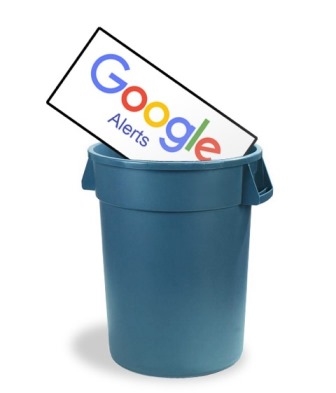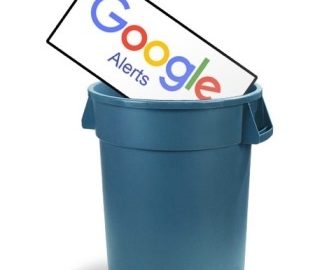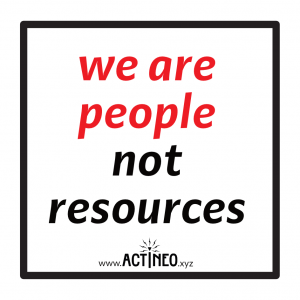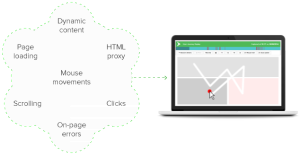— December 8, 2017

Google Alerts has long been a favorite online monitoring tool for many, including marketing and PR professionals, small businesses and even not so small organizations. After all, it’s free and easy to set up. Google’s name recognition attracts users who don’t know of alternatives.
Google Alerts has some outstanding disadvantages. Namely, it doesn’t work. Google Alerts is plagued by persistent complaints from users who are not receiving notifications. Google’s help forum hosts a very long list of complaints going back years from users not getting notifications. Observers say Google Alerts has been broken for years.
Google Alerts is Unreliable
The Financial Brand once relied heavily on the alerts. No longer. “It is now so unreliable that it has been rendered effectively useless,” wrote Jeffrey Pilcher, publisher of The Financial Brand, a news website for the financial services industry. “Users can forget about creating any new Alerts — those pretty much won’t work at all.”
Google dismisses users with responses like “Hi all, thanks for the update. We’re currently investigating this.” It has strayed from its internet search roots and has become afflicted by the “shiny new object syndrome,” Pilcher says, referring to Google+.
“Google Alerts is no longer a PR girl’s best beau for capturing client mentions across the web, writes Christina Goswiller for PR Couture. Because capturing client mentions across the internet is essential for your PR career, Google Alerts is not worth your time or the risk, Goswiller says. Other free monitoring services exist but, as the saying goes, you get what you pay for. Instead, opt for a paid monitoring service.
It Doesn’t Include Live TV & Radio Broadcasts
TV remains the foremost media for news; more people still rely on TV than on print or websites to get their news. It’s the news media that makes the greatest impression on the public. A story carried on network news has more impact than most any combination of print media exposure.
Almost all American households own at least one television, and about 50 percent of Americans obtain their news most frequently from television, compared to 43 percent who often get their news online, according to Pew Research.
Google Alerts does not include news from live TV or radio broadcasts. That creates a huge hole in any news alerts – and a wholly incomplete picture of the results of any PR campaign. Most subscription media monitoring services include broadcast monitoring.
It Doesn’t Monitor Social Media
Google Alert’s lacks social media monitoring. It monitors only the open internet such as online media and blogs, the traditional realm of Google’s search engine. That’s a substantial drawback. Many people now turn to social media to read news and to learn about and comment about products and services.
More Americans than ever obtain their news through social media and the figure continues to rise. According to the Pew Research Center, two-thirds (67 percent) of Americans say they get at least some of their news on social media and 20 percent do so often. Even older Americans, typically not considered heavy social media fans, increasingly view news stories on Facebook, Twitter or YouTube.
When people view news about a company, celebrity or topical issue, there’s a good chance they’ll see it social media. That’s probably why social media monitoring is one of the most critical factors determining executives’ satisfaction with their PR firms, according to the PR Customer Experience Benchmark Report from Researchscape International. More executives (57 percent) use PR firms for social media monitoring than for other services.
Social media listening enables companies to respond to customer service complaints, complete product research, obtain sales leads and competitive intelligence, and find user-generated content to share. Likewise, nonprofits turn to social media listening to grow their donations, recruit volunteers and increase awareness of their mission.
It Lacks Integrated Media Monitoring
In not monitoring broadcast news or social media, Google Alerts is unable to deliver an integrated view of all the media mentions. At best, it offers only a sliver of actual coverage. The missing coverage results in fewer media clips, a very cockeyed view of actual coverage that results in less favorable analytics.
The best media monitoring services integrate analytics from all media and social networks, including the client’s Google Analytics, into a single dashboard for a comprehensive and easy review. An integrated analytics approach provides a 360-degree view of how earned media, marketing or social media campaigns impact key business objectives.
Worst of All, Google Alerts Lacks Analytics
Google Analytics does not include analytics. It only reports, or at least is supposed to report, keywords. It does tell you if mentions of your brand are positive or negative or how your share of voice compares to competitors. It does not tell you if brand mentions, sentiment or share of voice is improving over time.
Social media analysis can provide a treasure trove of data. It can determine to what extent your audience is sharing your content. It can reveal details about your audience’s characteristics and what people really think about your organization. By gaining insights into how people feel about your products and services, you learn where you can make improvements.
Media measurement can demonstrate the value of public relations campaigns by analyzing brand mentions, brand sentiment, share of voice and other metrics. Anecdotal reports don’t convince numbers-oriented corporate executives of the value of public relations. PR professionals who track hard numbers with advanced media monitoring and measurement tools can show the value of their campaigns to clients and corporate superiors.
Bottom Line: Google Alerts has deteriorated and is no longer a viable option for monitoring mentions of your organization or other keywords. Experts have recommended against it for years. Because their careers depend on media monitoring, it’s critical for PR pros to rely on a paid media monitoring service that produces dependable results and monitors broadcast news and social media in addition to blogs and online news sites.
Schedule a Free Online Demo of the Glean.info Media Monitoring & Measurement Dashboard.
This post was originally published on the Glean.info blog.
Digital & Social Articles on Business 2 Community
(92)
Report Post





